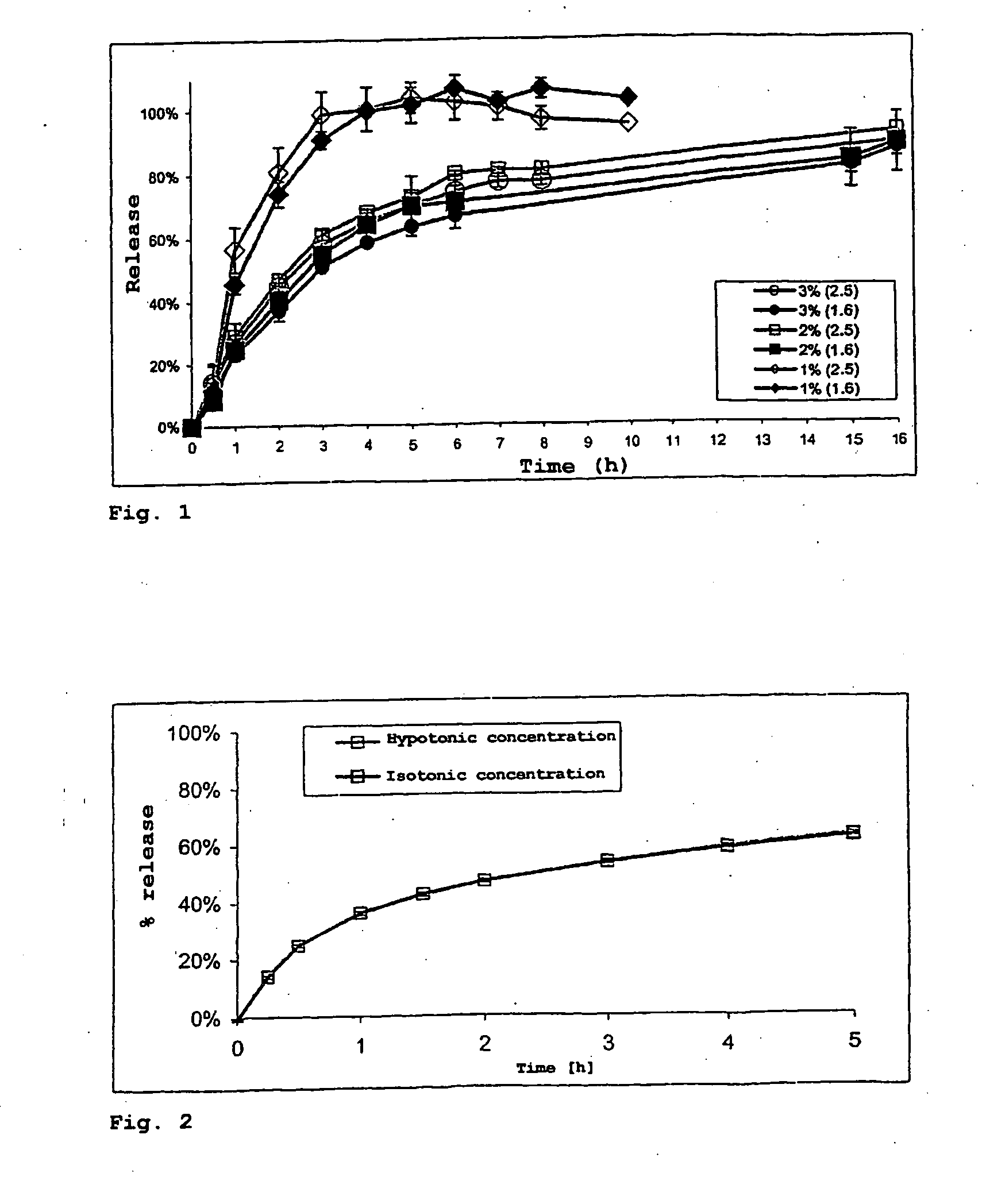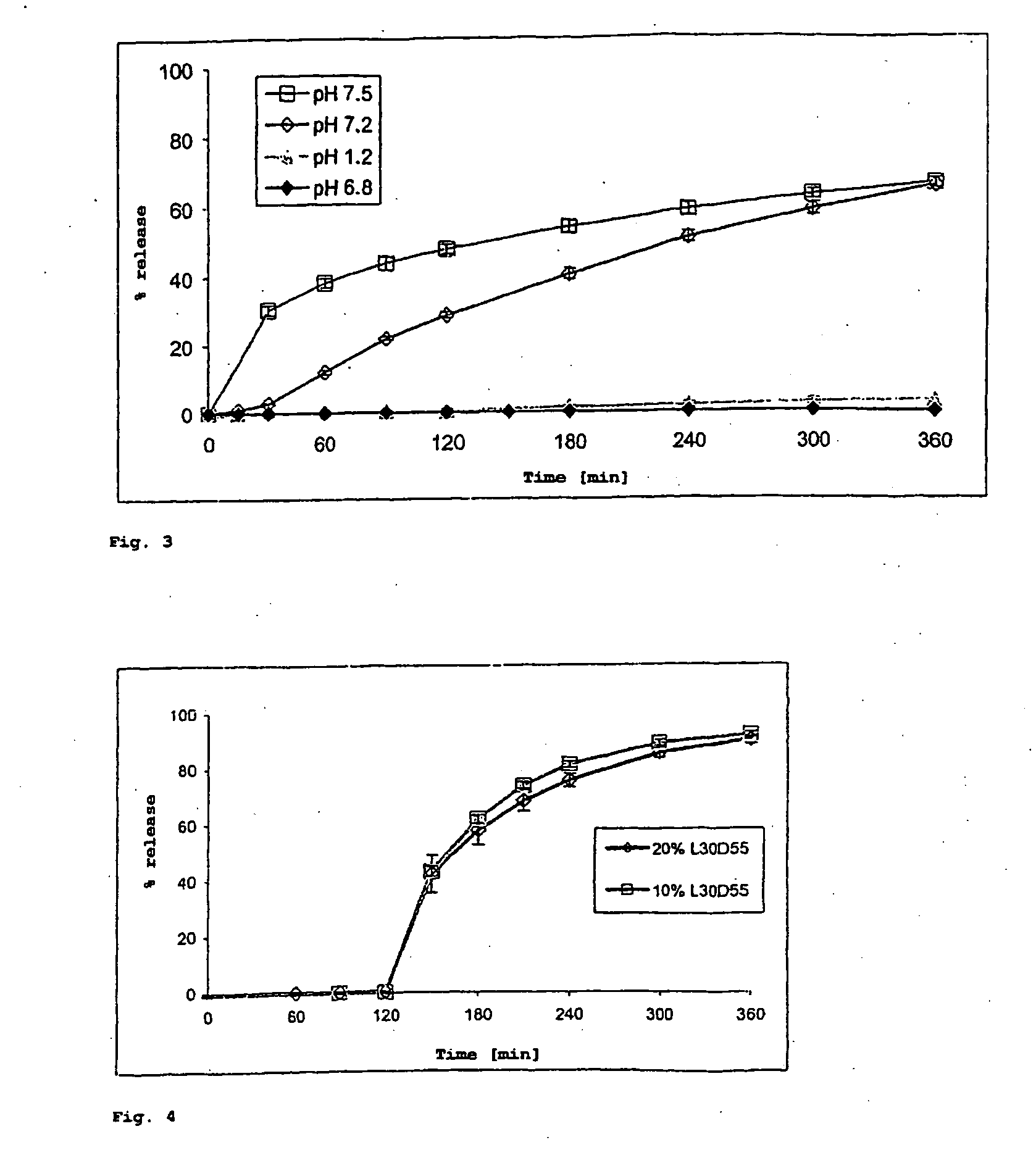Multilayer dosage forms, which contain active substances and which comprise a neutral core, and an inner and outer coating consisting of methacrylate copolymers and methacrylate monomers
a technology of methacrylate monomer and dosage form, which is applied in the direction of coatings, pill delivery, organic active ingredients, etc., can solve the problems of inability to reproduce active substance release characteristics, comparatively complicated production of dosage form, and inability to release active substance release characteristics
- Summary
- Abstract
- Description
- Claims
- Application Information
AI Technical Summary
Problems solved by technology
Method used
Image
Examples
example 1-3
Description of Experiments on Spray Embedding of Budesonide in Eudragit® NE 30 D (Copolymer of 65% by Weight Ethyl Acrylate and 35% by Weight Methyl Methacrylate)
[0133] It was investigated whether a delay of release which satisfies therapeutic requirements can be achieved by spray embedding. The formulations were for this purpose varied in the active substance-polymer ratio and the amounts of polymer applied. Specifically, the following polymer to budesonide ratios were produced: 2.5:1 and 1.6:1.
[0134] All these formulations were provided with a 3% (m / m) polymer application. In Example 1 (Eudragit® NE 30 D: budesonide 2.5:1) and Example 2 (Eudragit® NE 30 D: budesonide 1.6:1), a sample was in each case taken with a 1% and 2% polymer application. All the batches were mixed with 0.5% Aerosil 200 after production in order to prevent adhesion of the pellets during storage. It is presumed that the active substance budesonide acts as release agent. The release effect of budesonide was e...
example 4
Modification of the Start of Release by a Film Coating with Eudragit® FS 30 D
[0148] The coating batch corresponds to Example 1 (spray embedding of budesonide in Eudragit NE 30 D, polymer:active substance ratio 2.5:1, 3% m / m CDM) was coated-with Eudragit FS 30 D to modify the start of release. The resulting batch (2-24) was investigated in more detail for its in vitro release behavior. The aim was to slow release of budesonide, the intention being that release starts only in the terminal small intestine.
[0149] The release investigations carried out in pharmacopeia buffers with pH 1.2, 6.8, 7.2 and 7.5 show a suppression of release at pH 1.2 and 6.8 for Experiment 4 with 20% (m / m) CDM of Eudragit® FS 30 D. That is to say at pH values intended to simulate the stomach and the proximal small intestine. Release starts, with a short tlag phase of between 15 to 30 minutes, in buffer of pH 7.2. Release then follows a slow, almost linear course. The outer polymer does not yet dissolve in at...
example 5
Gastro-Resistant Coating with Eudragit® L 30 D-55
[0151] Experiment 5 was selected as prototype for the therapy of Crohn's disease and characterized in detail by in vitro release investigations. The batch is composed of a spray embedding of budesonide in Eudragit® NE 30 D with 1% (m / m) CDM applied and a gastro-resistant coating polymer, namely Eudragit® L 30 D-55 with 10% or 20% CDM applied. Since the gastro-resistant polymer coating is in direct contact with the embedding matrix, it was of interest to examine a possible influence of the coating on the release from the embedding. The test for resistance to gastric juice was carried out according to the USP 24 monograph “Delayed-release (Enteric-coated) Articles—General Drug Release Standard”, Method A. There was no measurable release in simulated gastric fluid over 2 hours either with 10% or 20% (m / m) polymer applied. After buffering to pH 6.8, release started without delay. It was observed that the release profile is scarcely influ...
PUM
| Property | Measurement | Unit |
|---|---|---|
| film-forming | aaaaa | aaaaa |
| glass transition temperature | aaaaa | aaaaa |
| pH | aaaaa | aaaaa |
Abstract
Description
Claims
Application Information
 Login to View More
Login to View More - R&D
- Intellectual Property
- Life Sciences
- Materials
- Tech Scout
- Unparalleled Data Quality
- Higher Quality Content
- 60% Fewer Hallucinations
Browse by: Latest US Patents, China's latest patents, Technical Efficacy Thesaurus, Application Domain, Technology Topic, Popular Technical Reports.
© 2025 PatSnap. All rights reserved.Legal|Privacy policy|Modern Slavery Act Transparency Statement|Sitemap|About US| Contact US: help@patsnap.com



